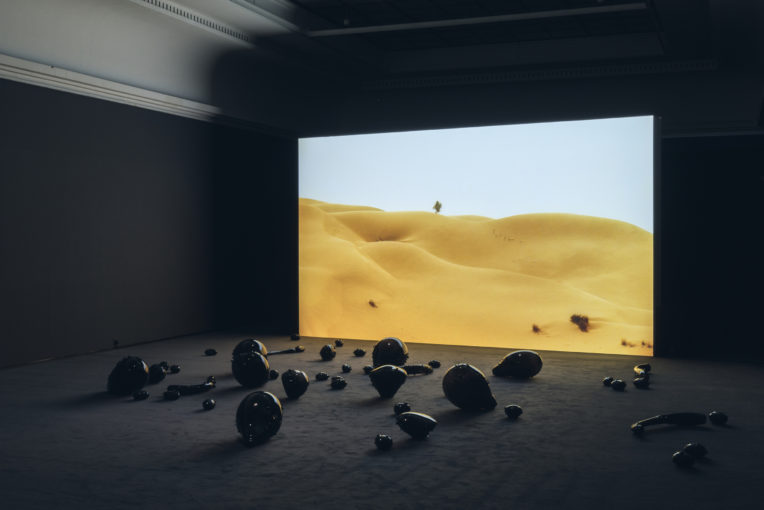In awe of the cosmos

Sand, light and rocks. Monira al-Qadiri’s installation "Holy Quarter" at the Haus der Kunst doesn’t display any classic desert fantasies. Rather, these are striking images of a landscape far from any civilisation.
The artist gave an introduction to her piece at the opening of the exhibition in Munich. It consists of black glass sculptures distributed around the room, and a video story that also features text and music. The images on the large screen in the darkened room are very powerful.
You can sense that al-Qadiri is engaging artistically with global issues, such as the question of what the future holds for a human race at the mercy of the climate crisis. But her perspective on these issues is expressly Arab.
Impressions of the "empty quarter"
Across the screen flicker images of sand dunes, rock formations and the great expanse of the "Rub al-Khali" desert, the "empty quarter" that lies between Saudi Arabia, Oman, Yemen and the United Arab Emirates. A single shrub grows out of a sea of sand. The video story demonstrates how small a human being is when faced with the forces of nature. It inevitably gives rise to questions about the meaning of life and the roots of human existence.
Al-Qadiri was born in 1983 in Dakar, the capital of Senegal. But her parents come from Kuwait, where she grew up. At the age of 16 she was drawn to Tokyo, where she studied multimedia art, gaining her doctorate there in 2010. After several years in Beirut, the artist now lives in Berlin.
The film, shot in the "empty quarter" with the help of a drone, forms a unified whole with the round black glass sculptures in front of the screen. One important starting point for the multimedia project was the story of the British explorer St. John Philby, who travelled around the "empty quarter" in the 1930s.
A fictional being with a mythological quality
In 1932, the Orientalist was searching for the ruins of an ancient city in this hostile environment when he became the first European to discover the Wabar crater. The British explorer took it to be an extinct volcano, but it had actually been created by the impact of meteorites. Wabar is regarded as the best-preserved example of a crater caused by a meteorite anywhere in the world.
But al-Qadiri sees more than a geological attraction in the remains of the meteorite. In her installation, Wabar becomes a fictional being with a mythological quality, who fell to earth from outer space. In the audio sequences played over the video, Wabar speaks words from St. John Philby’s diary mixed with notes from scientific journals and religious poetry.
"When you hold these pieces of meteorite in your hand, you can’t help but get a spiritual feeling for the endless vastness of the universe to which we are connected," she explains.
It was this feeling of awe for the cosmos that she wanted to carry over into her installation. The glass sculptures are reminiscent of the "Wabar pearls" in the meteorite crater, gleaming black stones formed in the sand by the impact. At the same time, their pearl shape is also an allusion to the era before the age of oil in Kuwait, when diving for pearls in the sea was still how people made their living.
From desert tent to skyscraper
Monira al-Qadiri is part of a young generation of Arab artists who are addressing the consequences of the age of oil for their societies: the cultural and social shift that followed the start of oil production was a radical one. Al-Qadiri’s grandfather worked as a singer on a pearl-fishing boat. Within a very short space of time, oil production had turned the lives of the region’s inhabitants completely upside down. In a single generation, they were catapulted from desert tent to skyscraper, from camel to Mercedes.

Al-Qadiri compares the dawning of the oil era to an invasion of aliens from outer space, like Wabar, the fictional space-creature. She argues that an imported western model of progress has made the region’s people completely forget their own cultural roots.
To this day, wealth and overconsumption in the region are based on oil, and al-Qadiri says that this has led to a disconnect between wealth and an inner emptiness. The black colour of the glass sculptures is a reference to the oil that shapes everything. But the artist is convinced that only those who recall the time before oil production can develop ideas for a post-fossil-fuel future.
The aesthetics of sadness
But in the Middle East, al-Qadiri argues, the past has been repressed and disappeared from the collective consciousness and so there are no credible ideas for a direction in which to develop. "The stories of our societies are crumbling," she says. "There is no vision for the future at all." She calls the situation in the Middle East "painful" and "tragic".
"All the same, for me there is an aesthetic quality to this oriental melancholy," she says, and she deliberately contrasts this with the western compulsion to be permanently cheerful. "The aesthetics of sadness in the Middle East" was also the title of her doctoral thesis. The future seems gloomy. But there are still the vital voices of young artists like al-Qadiri –and their huge creative potential.
Claudia Mende
© Qantara.de 2020
Translated from the German by Ruth Martin
